EVGA X79 Dark Review
by Ian Cutress on October 23, 2013 10:00 AM EST- Posted in
- Motherboards
- Intel
- EVGA
- X79
Readers of our motherboard review section will have noted the trend in modern motherboards to implement a form of MultiCore Enhancement / Acceleration / Turbo (read our report here) on their motherboards. This does several things – better benchmark results at stock settings (not entirely needed if overclocking is an end-user goal), at the expense of heat and temperature, but also gives in essence an automatic overclock which may be against what the user wants. Our testing methodology is ‘out-of-the-box’, with the latest public BIOS installed and XMP enabled, and thus subject to the whims of this feature. It is ultimately up to the motherboard manufacturer to take this risk – and manufacturers taking risks in the setup is something they do on every product (think C-state settings, USB priority, DPC Latency / monitoring priority, memory subtimings at JEDEC). Processor speed change is part of that risk which is clearly visible, and ultimately if no overclocking is planned, some motherboards will affect how fast that shiny new processor goes and can be an important factor in the purchase.
For clarification, EVGA does not use MultiCore Turbo. On BIOSes prior to 2.05, the system actually runs our 4960X at 3.7 GHz at any load, almost performing the antithesis of MultiCore Turbo and reducing single core speed. For clarity in our testing, we have included results in this mode, as well as the latest beta BIOS which implements turbo correctly, and what an MCT enabled EVGA X79 Dark would perform (under 4960X+ results).
Point Calculations - 3D Movement Algorithm Test
The algorithms in 3DPM employ both uniform random number generation or normal distribution random number generation, and vary in various amounts of trigonometric operations, conditional statements, generation and rejection, fused operations, etc. The benchmark runs through six algorithms for a specified number of particles and steps, and calculates the speed of each algorithm, then sums them all for a final score. This is an example of a real world situation that a computational scientist may find themselves in, rather than a pure synthetic benchmark. The benchmark is also parallel between particles simulated, and we test the single thread performance as well as the multi-threaded performance.
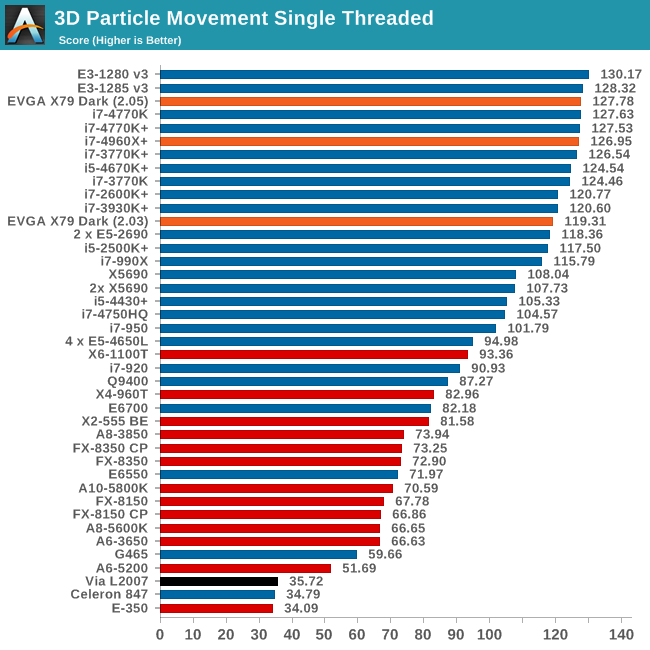
The effect of BIOS 2.03 on the EVGA means ~ 7% worse performance in single threaded apps than standard Intel specifications.
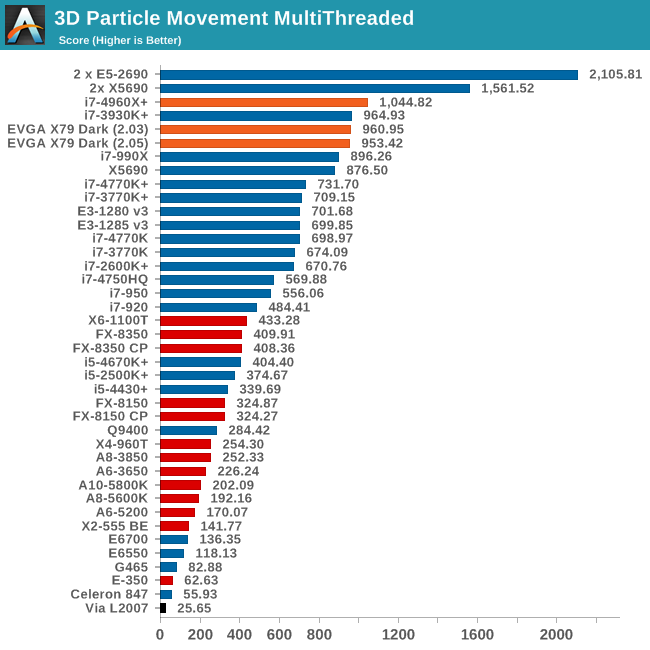
In multithreaded mode, the system loses out to MCT enabled X79 motherboards by almost 9%.
Compression - WinRAR 4.2
With 64-bit WinRAR, we compress the set of files used in the USB speed tests. WinRAR x64 3.93 attempts to use multithreading when possible, and provides as a good test for when a system has variable threaded load. WinRAR 4.2 does this a lot better! If a system has multiple speeds to invoke at different loading, the switching between those speeds will determine how well the system will do.
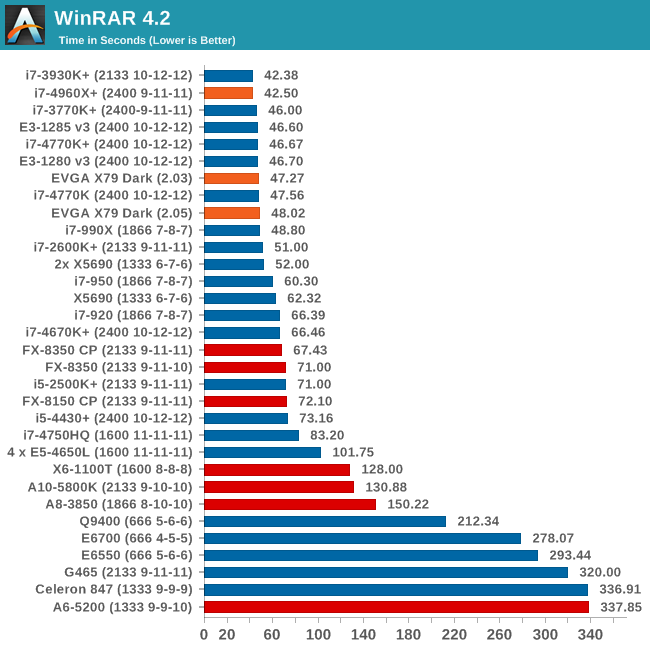
The variable threaded nature of WinRAR shows a distinct advantage in using an MCT enabled motherboard out of the box.
Image Manipulation - FastStone Image Viewer 4.2
FastStone Image Viewer is a free piece of software I have been using for quite a few years now. It allows quick viewing of flat images, as well as resizing, changing color depth, adding simple text or simple filters. It also has a bulk image conversion tool, which we use here. The software currently operates only in single-thread mode, which should change in later versions of the software. For this test, we convert a series of 170 files, of various resolutions, dimensions and types (of a total size of 163MB), all to the .gif format of 640x480 dimensions.
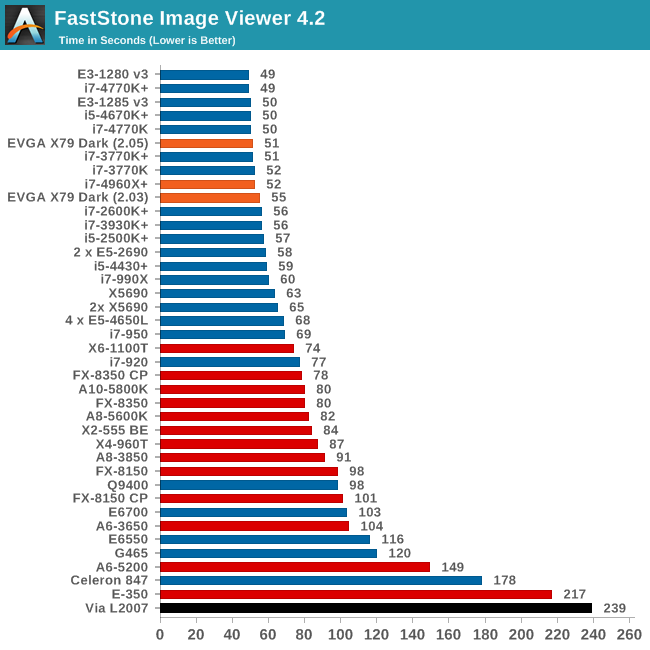
Video Conversion - Xilisoft Video Converter 7
With XVC, users can convert any type of normal video to any compatible format for smartphones, tablets and other devices. By default, it uses all available threads on the system, and in the presence of appropriate graphics cards, can utilize CUDA for NVIDIA GPUs as well as AMD WinAPP for AMD GPUs. For this test, we use a set of 33 HD videos, each lasting 30 seconds, and convert them from 1080p to an iPod H.264 video format using just the CPU. The time taken to convert these videos gives us our result.
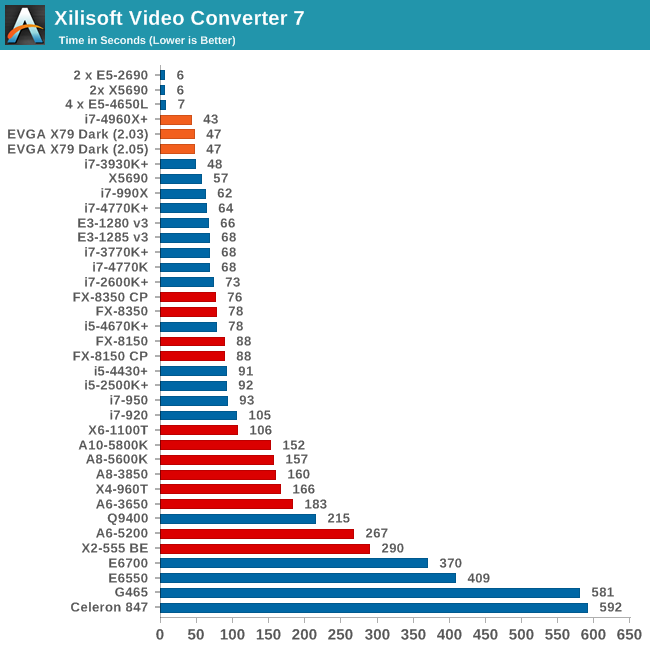
Rendering – PovRay 3.7
The Persistence of Vision RayTracer, or PovRay, is a freeware package for as the name suggests, ray tracing. It is a pure renderer, rather than modeling software, but the latest beta version contains a handy benchmark for stressing all processing threads on a platform. We have been using this test in motherboard reviews to test memory stability at various CPU speeds to good effect – if it passes the test, the IMC in the CPU is stable for a given CPU speed. As a CPU test, it runs for approximately 2-3 minutes on high end platforms.

Video Conversion - x264 HD Benchmark
The x264 HD Benchmark uses a common HD encoding tool to process an HD MPEG2 source at 1280x720 at 3963 Kbps. This test represents a standardized result which can be compared across other reviews, and is dependent on both CPU power and memory speed. The benchmark performs a 2-pass encode, and the results shown are the average of each pass performed four times.
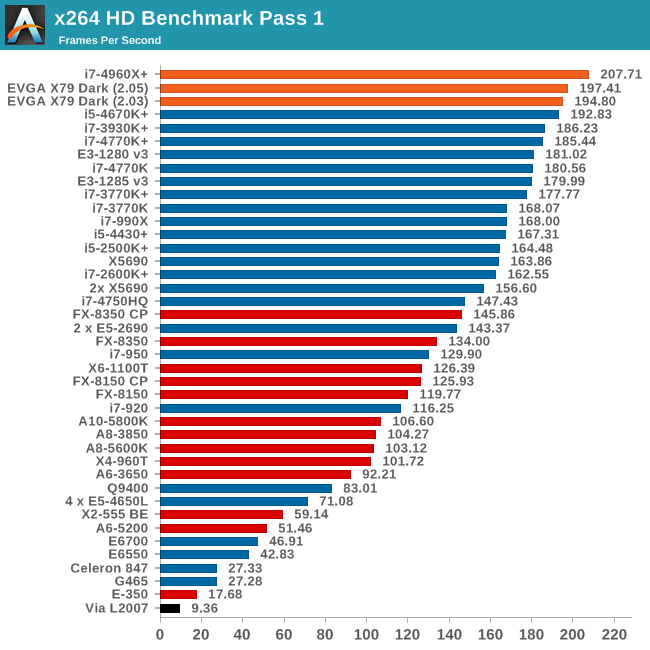

Grid Solvers - Explicit Finite Difference
For any grid of regular nodes, the simplest way to calculate the next time step is to use the values of those around it. This makes for easy mathematics and parallel simulation, as each node calculated is only dependent on the previous time step, not the nodes around it on the current calculated time step. By choosing a regular grid, we reduce the levels of memory access required for irregular grids. We test both 2D and 3D explicit finite difference simulations with 2n nodes in each dimension, using OpenMP as the threading operator in single precision. The grid is isotropic and the boundary conditions are sinks. Values are floating point, with memory cache sizes and speeds playing a part in the overall score.

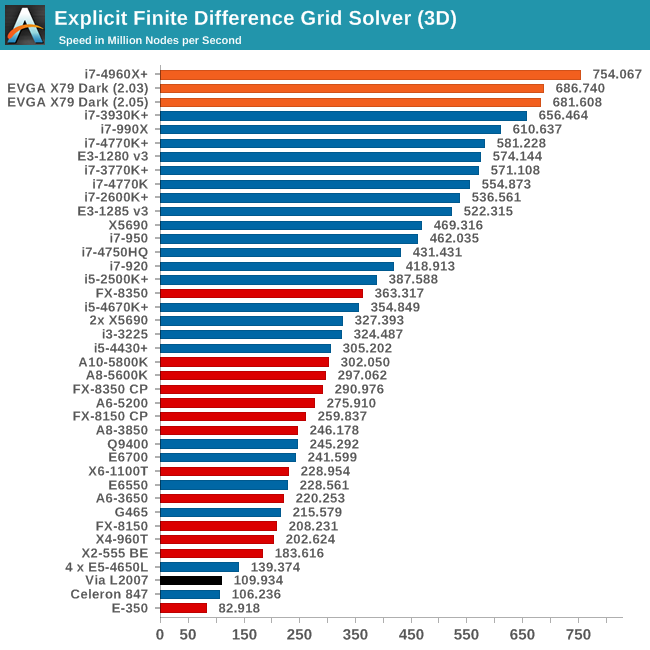
Grid Solvers - Implicit Finite Difference + Alternating Direction Implicit Method
The implicit method takes a different approach to the explicit method – instead of considering one unknown in the new time step to be calculated from known elements in the previous time step, we consider that an old point can influence several new points by way of simultaneous equations. This adds to the complexity of the simulation – the grid of nodes is solved as a series of rows and columns rather than points, reducing the parallel nature of the simulation by a dimension and drastically increasing the memory requirements of each thread. The upside, as noted above, is the less stringent stability rules related to time steps and grid spacing. For this we simulate a 2D grid of 2n nodes in each dimension, using OpenMP in single precision. Again our grid is isotropic with the boundaries acting as sinks. Values are floating point, with memory cache sizes and speeds playing a part in the overall score.

Point Calculations - n-Body Simulation
When a series of heavy mass elements are in space, they interact with each other through the force of gravity. Thus when a star cluster forms, the interaction of every large mass with every other large mass defines the speed at which these elements approach each other. When dealing with millions and billions of stars on such a large scale, the movement of each of these stars can be simulated through the physical theorems that describe the interactions. The benchmark detects whether the processor is SSE2 or SSE4 capable, and implements the relative code. We run a simulation of 10240 particles of equal mass - the output for this code is in terms of GFLOPs, and the result recorded was the peak GFLOPs value.
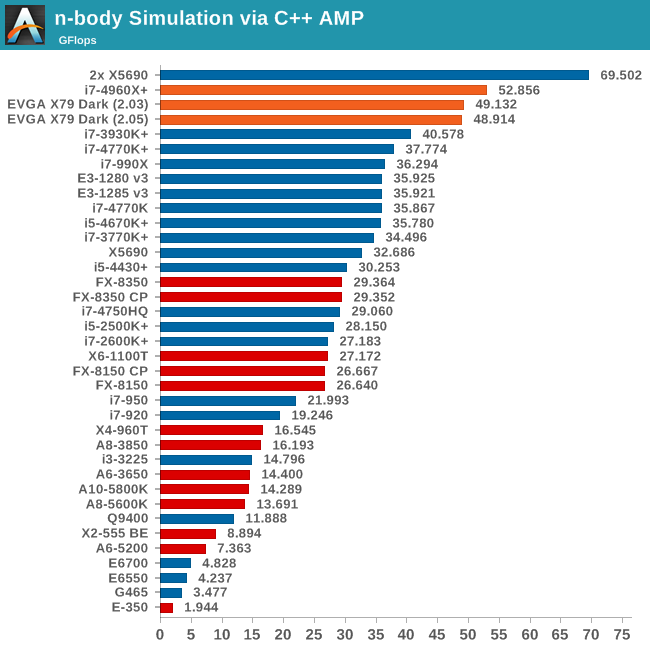










23 Comments
View All Comments
DanNeely - Wednesday, October 23, 2013 - link
How solidly anchored is the 24pin ATX socket, and how stiff is the board itself? I've always assumed the reason I've never seen a sideways version of one was that the thickness and stiffness of the cable meant that if used in cases with behind the board cabling or that had limited space in front of the board would result in excess torque being applied.kolemunky - Wednesday, October 23, 2013 - link
board is made of good quality material( stiff) and 24 pin is securely attached, but its location makes it very difficult for removal unless the board is removed from the case. Ive had this board since launch and can verify that the bios situation is as bad as the reviewer states. 2.07 does fix some of the overclocking bugs, but there are other issues that still persist. disabling marvell raid ports disables USB 3.0 ports. ? I have 4 ssds setup as a bootable raid-0 and have had it fail 3 times, once randomly, 2 others after updating the bios, 2.04, 2.07. considering this tech has been around 2 years , I don't see how they couldn't get this board rock solid day one. There are no features on the board that justify the price tag. Raid performance on marvell ports is abysmal. USB ports have serious issues. RIVE is a better buy and a better performer. I have already sold this board and am waiting for the RIVE black. I would advise anyone on picking up this board to look elsewhere. One look in the forums and you will understand why.DanNeely - Wednesday, October 23, 2013 - link
I'm not surprised about installing the cable being a pain; in smaller/older cases even the angled sata ports can be a problem.Flunk - Friday, October 25, 2013 - link
I can attest to that. I used to use a SilverStone SUGO SG-03 for a SLI setup. Any angled connectors on the board are evil and should be expunged. Its less of an issue on an EATX board because the required cases are enormous but still annoying.DanNeely - Friday, October 25, 2013 - link
The angled sata connectors are due to SLI/xFire on ATX/mATX boards; because there's not enough space near the southbridge to fit them in somewhere they're not at risk of being blocked by longer cards.CecileWamsley - Monday, October 28, 2013 - link
My Uncle Julian got metallic MINI Cooper Clubman just by some part time working online with a macbook air... visit their website... http://smal.ly/8wUo2ConcreteBrew - Tuesday, March 17, 2015 - link
I have built ten high end machines using EVGA boards and I have never seen more eye candy or enjoyed tweaking it where "no man has ever been before" in a motherboard; including ASUS's Rampage IV which lasted a little over a year before giving up the ghost. Although supposedly still under warranty, I spent weeks trying to get an RMA from ASUS and finally gave up. This particular board is in my opinion, perfection at its best. It is significantly thicker and sturdier than the Rampage and the ATX socket, along with the rest that are at 90 degrees including the USB 3.0 to make room for that fourth GPU, are as stiff as in their vertical position. In fact, you can see the thickness of the metal framing coming through the board if you peel back the thick rubber insulation. These are all innovations and not gimmicks that I have found to be a constant with EVGA products. Never mind the fact that their technical support is available 24/7 for customers that have registered their products. They have a toll-free number and normally, you are on the phone with a live individual within two or three minutes. Better yet, they speak excellent English and and do know what they are talking about. You can't find anything this good anywhere. And best of all, they resolve your problems rather than put you off. And when warranted, you will hang -up with an RMA that is already in process.garnetandblack - Wednesday, October 23, 2013 - link
This review is spot on. Great hardware, for the most part - troubling bios.EVGA's previous x79 boards were just as bad (if not worse) in this regard.
warezme - Wednesday, October 23, 2013 - link
Troubling to hear. I have always bought EVGA boards, usually the latest releases when I build a new system. Their boards are usually solid well built and their technical support and return policy are the best. You call and get to speak with real people.iamkyle - Wednesday, October 23, 2013 - link
eVGA's last solid board was the X58 classified. Everything has gone downhill since then and I can't understand why.